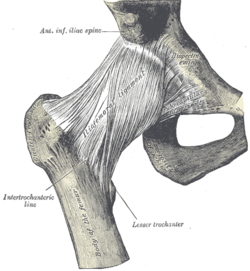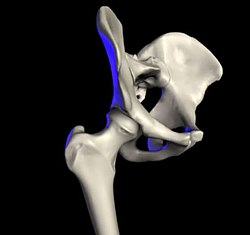This is an old revision of this page, as edited by Rodsan18 (talk | contribs) at 17:57, 20 October 2007 (tl:Pigi). The present address (URL) is a permanent link to this revision, which may differ significantly from the current revision.
Revision as of 17:57, 20 October 2007 by Rodsan18 (talk | contribs) (tl:Pigi)(diff) ← Previous revision | Latest revision (diff) | Newer revision → (diff)- For other uses of the term, see hip (disambiguation).
| Hip (anatomy) | |
|---|---|
 Right hip-joint from the front. Right hip-joint from the front. | |
 Bones of the hip Bones of the hip | |
| Details | |
| Identifiers | |
| Latin | coxa |
| MeSH | D006615 |
| TA98 | A01.2.08.005 A01.1.00.034 |
| TA2 | 316, 158 |
| FMA | 24964 |
| Anatomical terminology[edit on Wikidata] | |
In anatomy, the hip is the bony projection of the femur which is known as the greater trochanter, and the overlying muscle and fat. The hip joint is the joint between the femur and acetabulum of the pelvis and its primary function is to support the weight of the body in both static (e.g. standing) and dynamic (e.g. walking or running) postures.
Description of the bones of the hips
The hip bones are divided into 5 areas, which are:
- The sacrum: This is a bone at the base of the vertebral column that is created by the fusion of 4 vertebrae. It attaches to the ilium on the sides. It also provides a point of muscle attachment for back muscles.
- The coccyx (also called the tail bone): This is a small vestigial bone that attaches to the base of the sacrum. It is created from the fusion of 4 small vertebrae.
- The ilium: This is the largest area of the hip bones. It consists of 2 large broad plates, one on each side, which serve to support the internal organs, and to provide attachment for muscles of the back, sides, and buttocks. The hip joint of the femur is part of the ilium.
- The ischium: The ischium consists of 2 broad curves of bone, one on each side, which lie below the ilium, and are attached to the pubis in the front and the ilium in the back. The ischium serves as a place of attachment for muscles. When a person's butt hurts from sitting on a hard surface, it is the result of the sharp ischium pressing on the buttocks.
- The pubis: The pubis is the front-most area of the hip bones. It attaches to the ilium on the sides and the ischium on the bottom. It provides structural support, and serves as a place of attachment for the muscles of the inner thigh.
Movements
Seven different kinds of movements are possible in the hip joint:
- Flexion and extension on or from the spine or on or from the thigh
- Abduction and adduction of the femur
- Internal (medial) and external (lateral) rotation of the pelvis, thigh or spine
- Circumduction of the femur or pelvis
A synovial joint that can produce movement in more than one axis is called a multiaxial joint.
Anatomy of the hip joint
Articulation
The hip joint is a synovial joint formed by the articulation of the rounded head of the femur and the cup-like acetabulum of the pelvis. It is classified as a ball and socket joint. It forms the primary connection between the bones of the lower limb and the axial skeleton of the trunk and pelvis. Both joint surfaces are covered with a strong but lubricated layer called articular hyaline cartilage. The cuplike acetabulum forms at the union of three pelvic bones and the joint may not be fully ossified (the process of forming bone) under the age of 25 years. The depth of the acetabulum is increased by a fibrocartilaginous rim called a labrum that grips the head of the femur and secures it in the joint. The acetabulum is oriented inferiorly, laterally and anteriorly. The magnitude of inferior orientation can be assessed using a line connecting the lateral rim of acetabulum and center of femoral head. This lines forms an angle with vertical known as center edge angle or angle of Wiberg. The magnitude of anterior orientation is referred as angle of acetabular anteversion.
The large head of the femur is completely covered in hyaline cartilage except for a small area called the fovea or pit. This is the site of attachment for an intracapsular ligament (called the ligamentum teres) that attaches directly from the head of the femur to the acetabulum. The head of the femur is attached to the pelvis by a thin neck region that is often prone to fracture in the elderly, mainly due to the degenerative effects of osteoporosis.
Capsule
The strong but loose fibrous capsule of the hip joints permits the hip joint to have the second largest range of movement (second only to the shoulder) and yet support the weight of the body, arms and head.The capsule is attached proximally to the entire periphery of the acetabulum beyond acetabular labrum.The capsule covers the femoral head and neck like a sleeve and attaches to the base of neck. The capsule has two sets of fibers:the longitudinal and circular fibers.The circular fibers forms a collar around the femoral neck called the zona orbicularis.the longitudinal retinacular fibers travel along the neck and carry blood vessel. As the line of gravity falls posterior to the axis of the hip joint, the combined weight of the body seeks to extend the hip joint in normal standing and make the trunk fall backwards to the ground. To resist the stretching action on the anterior joint capsule in normal upright posture, the hip has two very strong anterior ligaments.
Ligaments
The hip joint is reinforced by three main ligaments.
- At the front of the joint, the strong iliofemoral ligament attaches from the pelvis to femur. This Y-shaped ligament is also known as the ligament of Bigelow. This ligament seeks to resist excessive extension of the hip joint. It is often considered to be the strongest ligament in the human body.
- The pubofemoral ligament attaches across the front of the joint from the pubis bone of the pelvis to the femur. This ligament is orientated more inferiorly than the iliofemoral ligament and reinforces the inferior part of the hip joint capsule. It also blends with the medial parts of the iliofemoral ligament.
- The posterior of the hip joint capsule is reinforced by the ischiofemoral ligament that attaches from the ischial part of the acetabular rim to the femur.
There is also a small ligament called ligamentum teres or the ligament of the head of the femur. The ligament is a triangularly shaped band with its base on both sides of peripheral edge of acetabular notch. This structure is not that important as a ligament but can often be vitally important as a conduit of a small artery to the head of the femur. This arterial branch is not present in everyone but can become the only blood supply to the bone in the head of the femur when the neck of the femur is fractured or disrupted by injury in childhood.
Blood supply and nerve supply of the hip joint
The hip joint is supplied with blood from the medial circumflex femoral and lateral circumflex femoral arteries, which are both usually branches of the deep artery of the thigh (profunda femoris), but may also arise directly from the femoral artery. There is also a small contribution from a small artery in the ligament of the head of the femur which is a branch of the posterior division of the obturator artery, which becomes important to avoid avascular necrosis of the head of the femur when the blood supply from the medial and lateral circumflex arteries are disrupted (e.g. through fracture of the neck of the femur along their course).
The hip has two anatomically important anastomoses, the cruciate and the trochanteric anastomoses. These exist between the femoral artery or profunda femoris and the gluteal vessels.
The hip joint is supplied by a number of nerves (proprioception, nociception, etc...) including the femoral nerve, the obturator nerve, superior gluteal nerve, and the nerve to quadratus femoris.
Muscles producing movements at the hip joint
Main article: Muscles of the hipThe muscles that cause movement in the hip can be divided into five groups according to their orientation around the hip joint:
- the extensors group includes gluteus maximus and hamstrings
- the lateral rotator group includes obturator internus and externus, gemellus superior and inferior, quadratus femoris and piriformis
- the adductor group includes pectineus, adductor brevis, longus and magnus.
- the flexor group includes iliopsoas, rectus femoris, tensor fascia lata and sartorius
- the abductor group include gluteus medius and minimus.
These muscles produce flexion, extension, lateral rotation, medial rotation, abduction, and adduction.
Many of the hip muscles are responsible for more than one type of movement in the hip, as different areas of the muscle act on tendons in different ways.
Sexual dimorphism in humans
In humans, unlike other animals, the hip bones are substantially different in the two sexes. The hips of human females are broader and deeper than those of males. The femurs are also more widely spaced in females, so as to widen the opening in the hip bone and thus facilitate childbirth. Finally, the ilium and its muscle attachment are shaped so as to situate the buttocks away from the birth canal, where contraction of the buttocks could otherwise damage the baby.
Cultural significance of hips

It should also be noted that hips have long been associated with both fertility and general expression of sexuality. Since broad hips facilitate child birth and also serve as an anatomical cue of sexual maturity, they have been seen as an attractive trait for women for thousands of years. Many of the classical poses women take when sculpted, painted or photographed, such as the Odalisque, serve to emphasize the prominence of their hips. In Western society, this often harks back to classical notions of female beauty, particularly in the Venus Kallipygos. Similarly, women's fashion through the ages has often drawn attention to the girth of the wearer's hips.
See also
- Hip examination
- Hip replacement
- Snapping Hip Syndrome
- Female body shape
- WHR (Waist-Hip Ratio)
Additional images
External links
| Joints and ligaments of the human leg | |||||
|---|---|---|---|---|---|
| Hip | |||||
| Knee |
| ||||
| Tibiofibular |
| ||||
| Foot | |||||
| Human regional anatomy | |||||
|---|---|---|---|---|---|
| Body | Skin | ||||
| Head | |||||
| Neck | |||||
| Torso (Trunk) | |||||
| Limbs |
| ||||
